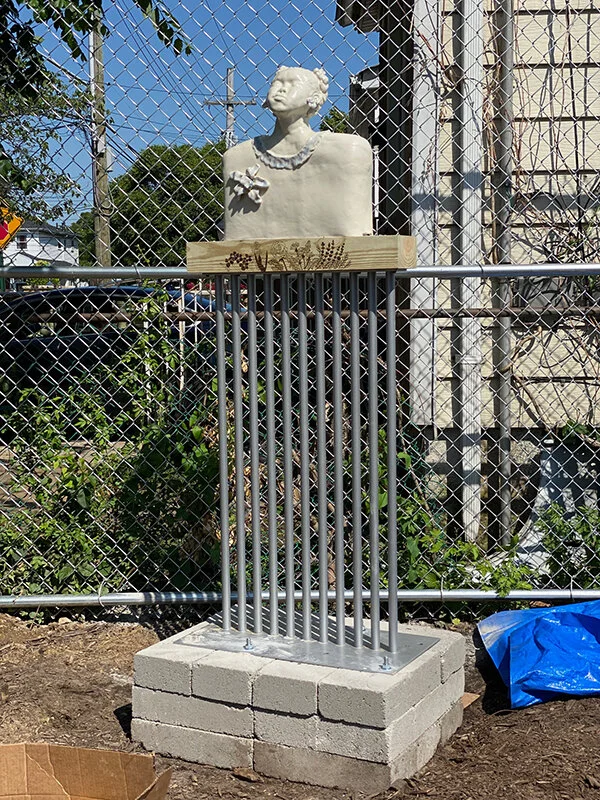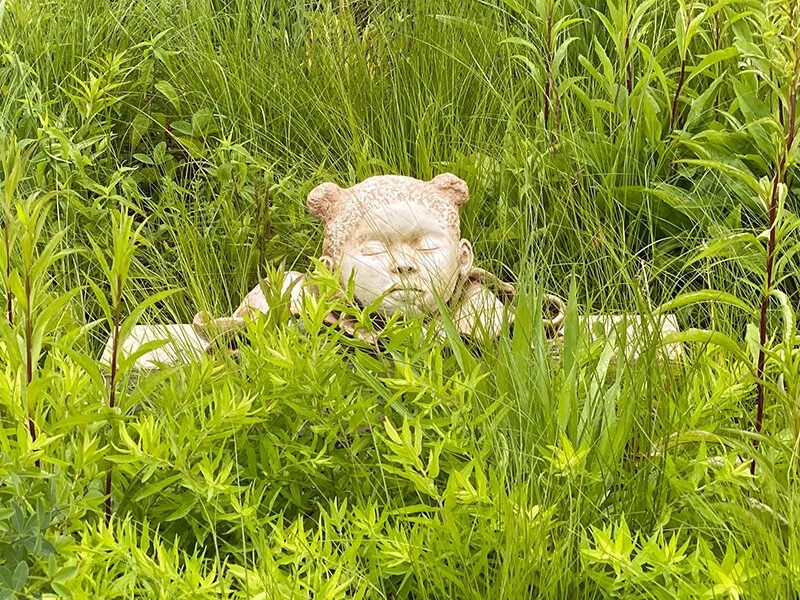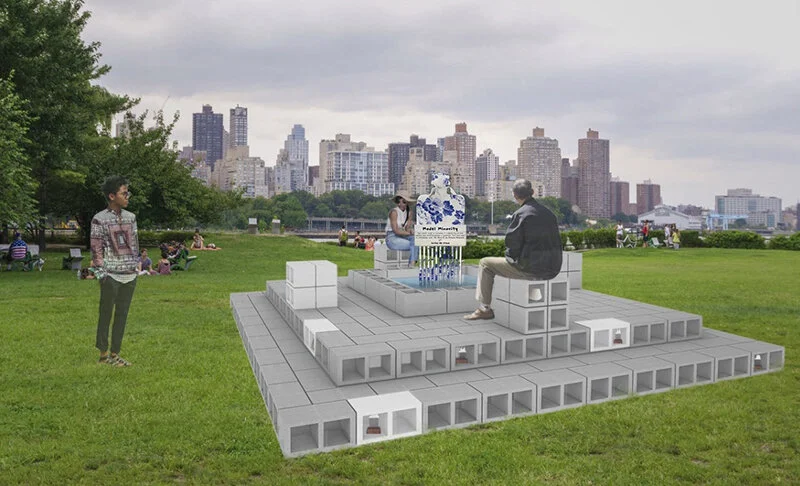Studio Visit | Yvonne Shortt
Yvonne Shortt, Afro Pick: Flower Power. Garden of Resilience, Queens, NY. Wood, steel and porcelain; 3’x2’ x 6’8”. Image courtesy of the artist.
Studio Visit: Yvonne Shortt
About a year ago, while combing her hair, Yvonne Shortt began to wonder about the origins of the afro-pick. Her research traced these tools to Egypt, nearly 5,500 years ago. Shortt learned that ancient “afro combs '' (as they are called by historians) often incorporated narrative elements. Above the tines of the wood or stone device, a sculptor would have recreated a scene from everyday life such as a loving gesture between two people.
With the production of metal combs during the 1970s, afro-picks became an emblem of counter-cultural trends. A Black fist on the handle referenced the Black Power movement. Black people styled their afros using these picks, embedding them in their hair as a statement. Shortt said, “The afro-pick went from telling stories to becoming a symbol of a revolution.”
As a public artist with a social practice, Shortt is rekindling the narrative potential of the afro-pick. Her picks are one facet of an ongoing tri-part series called African American Marbleization: An Act of Civil Disobedience. This body of work began several years ago and takes the form of objects such as the picks, sculptural works called “fragments”, and architectural forms.
A fountain to be installed this summer at the Underground Railroad Museum in Albany, New York is one of the series’s architectural elements, whereas Shortt’s “fragments'' depict parts of faces. Often these facial sculptures document sites where Shortt has experienced microaggressions. Other times, these sculptures function as an invitation for conversations about the experiences of people of color. One fragment graces the Ely Center of Contemporary Art entrance, where Shortt has been an artist in residence since May.
In the backyard of the New Haven art space, Shortt has been collecting stories from the community. She listens as strangers discuss transatlantic moves and other details from their lives. With several of Shortt’s afro-picks on view in the Collision Room, many have reminisced about hair. One woman described her mother, a confident woman who wore her hair in an afro. Another shared the reasons for wearing her hair in a weave.
Shortt blends snippets from people’s lives with aspects of her own experiences into the narrative handles. Some of the sculptures are large — around five or six feet tall — while others have a more intimate, handheld scale. Many are made using clay enriched with locally harvested soil.
This fall, Shortt plans to share the audio of the stories with the culmination of the project, coinciding with City-Wide Open Studios. In the meantime, Shortt, who has family connections in the New Haven area, has been coordinating with the Eli Whitney Museum in Hamden and the New Haven Free Public Library system to devise other opportunities for collecting stories from the public. She is also seeking additional venues for sharing her work around New Haven.
Closer to her Queens studio, six of Shortt’s afro-picks will be unveiled on Queens College campus in the next month. Then, over the academic year, Shortt will collaborate with students to create six new handles. The handles made with the students will replace the tops of the picks installed this summer.
For Shortt, this location is personal: she received a second master’s degree in Urban Design at Queens College. Surveying the grounds recently, she noticed that there were few examples of public art. And taken as a whole, the public art at Queens College did not reflect the diversity of the student body.
Shortt also discovered that there are fewer African American students and faculty on the campus than the representation of this demographic within the area. “I wanted to create a body of work for that audience,” she said, “so these students might feel more welcome here.”
Yvonne Shortt, a sculpture in situ in Newtown, Connecticut. Image courtesy of the artist.
A goal of the African American Marbleization series — and Shortt’s practice as a whole — is to defy the stereotypes associated with public art. Public art can be tiny. It can be ephemeral and whimsical. It can also be made by women, non-binary people, and non-white artists. By nature, public art is collaborative, though many times, large-scale sculptures appear to result from the studio of an individual. Too often, that individual is a white man with a prestigious educational background.
Short explained, “If you’re a woman, it’s hard to be a public artist. If you’re Black, it’s hard to be a public artist. But it’s not just about me and my practice. I want to create opportunities for other people.”
Since her practice began about a decade ago, Shortt has been attuned to others. She came to public art following an unlikely background. For nearly twenty years, Shortt worked for financial companies within the tech field writing algorithms. When she relocated to Queens from Manhattan, she became an accidental caretaker of community spaces close to her home.
“I was walking around these junky spaces and trying to stay away from the dead rats,” she said. “I didn’t like the way that these public spaces were looking, and I wanted something else.” Her desire for a cleaner, more inviting environment launched her new career in the arts.
With the community in mind, Shortt reached out to others to help her revitalize the decrepit spaces in Rego Park. Since her first project, she has surrounded herself with knowledgeable people such as civil engineers, artisans, and craftspeople. Shortt equally shares her expertise, time, and labor with others, too.
From the beginning, her methodology has been question-based. When Shortt wanted to learn how to build a bench, she teamed up with people who had the skills and equipment. Shortt is not a formally trained artist, but she has learned specialized fabrication techniques such as welding as a way to reduce her production costs.
Her approach to the subject of money may surprise readers given her prior career. Her website states: “The cost of my women's hours can not be calculated, packaged, or commoditized”, and her profile on Instagram likewise indicates that nothing on display is for sale.
Unlike many artists who specialize in public spaces, Shortt often begins projects before she has secured funding. She said, “I strongly believe that public art should be accessible for the community. As artists, we shouldn’t be relying on funders or be an asset in their portfolio.” Shortt doesn’t want any forces outside of herself to become a gatekeeper for her creativity.
But this doesn’t mean that Shortt does not have backers. “I tend to meet people where they are,” she explained. The way she tackles funding is unique to her goals and the individual project. For example, to raise funds for a project in the Elmhurst Sculpture Garden, Shortt grew and sold bulbs. She also harvested food. As part of the “Women Who Build” project, she created a mobile design studio to grow skills such as using a miter saw. Soon many other women pooled their resources, and together they built a house on wheels.
Shortt has been very successful as a fundraiser, too. When the mobile design studio caught the attention of someone at the Awesome Foundation, she received a $1,000 donation. Soon after, the Eileen Fisher Foundation gave an additional $15,000. “I realize what I want to do, and the models for making money come in later,” she stated. Many public artists are beholden to funding to realize their projects, but Shortt’s ideas always lead. It’s a reversal of the order that many public artists follow.
Yvonne Shortt, detail of Afro Pick Handle. Porcelain; 22”x6”x20”. Image courtesy of the artist.
Another unusual aspect of Shortt’s practice is how much energy she devotes to making space for others — literally and figuratively speaking. While many artists revel in their own success and output, Shortt’s desire to champion the work of other artists is distinct within the field.
“For a long time, I struggled with calling myself an artist,” Shortt said. “As artists, we don’t need to be talking about our own work all the time. We need to talk about the ways that we are creating opportunities for others, too.”
She’s currently working on making room for artists within a territory that is new for Shortt — a gallery. Last January, Shortt joined the A.I.R. Gallery, the first all-female artists cooperative in the United States, and she now chairs a new Research and Development committee. The committee is focused on creating more equitable models for galleries. They are brainstorming new spaces for artwork and novel frameworks for reviewing and selling work.
Shortt described how the application process for the gallery’s annual open call, observing that artists don’t always understand the services or opportunities that should expect. One of Shortt’s goals is to increase the transparency of the costs and benefits within the A.I.R. gallery model, and then apply those new systems to other art spaces.
For artists who want to profit from their work, the committee will quantify the sales from the upcoming exhibition Reviewed and Sold: What’s Next. Other benefits— such as an opportunity to receive critical feedback or the ability to connect with like-minded creators — are less tangible. Nonetheless, Shortt believes that the system should be examined and rebuilt with the needs of artists in the forefront.
To that end, she’s been asking artists what information they would like to see when applying for an exhibition. “We plan to use that feedback to pioneer a new, bold way of making an open call more transparent. That will increase the value that we give to artists,” she said.
“Everything we gather from this project, we will share so that other women can learn and more people can be a part of the art world.”
Throughout her career, Shortt has sidestepped many of the traditional pathways toward success. Many aspects of her practice rely on her ability to listen — to the experiences of students, the wants of women, and the desires of other artists. As she gathers and shares these stories through her sculptures and her work as an arts administrator, Shortt is fashioning a more accessible art world.
Yvonne Shortt, Rendering of Sanctuary — to be installed in Socrates Sculpture Garden in September. Dimensions: 13’ 4” 13’ 4” x 6’. Image courtesy of the artist.
Yvonne Shortt’s works from her series, African American Marbleization: An Act of Civil Disobedience are on view at the Ely Center for Contemporary Art through October 2021.
*All quotes are from a conversation with the author on June 16, 2021, over Zoom.







